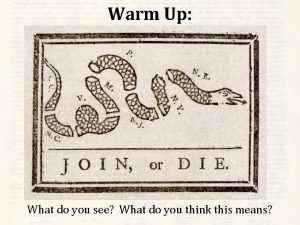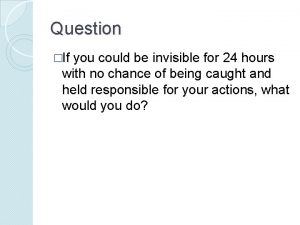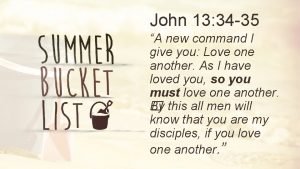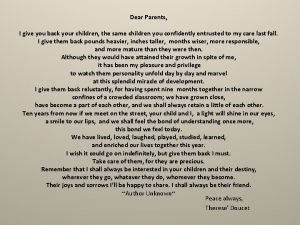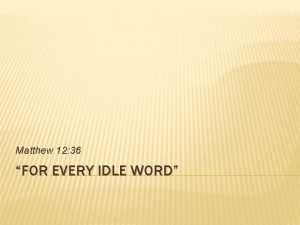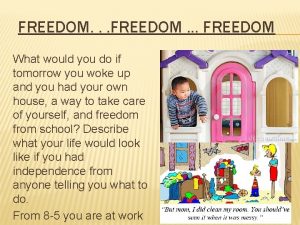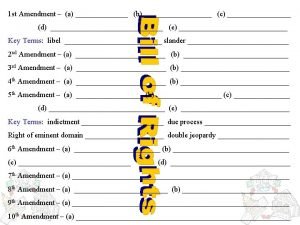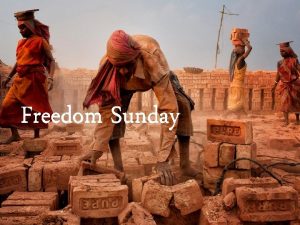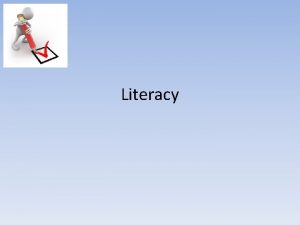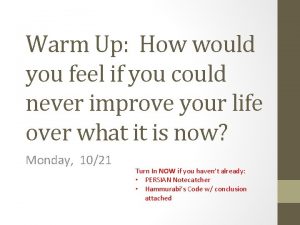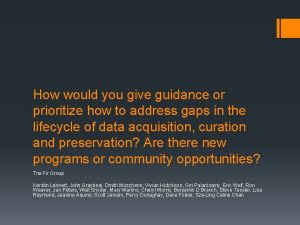AGENDA Warm Up What Freedom Would you give























- Slides: 23

AGENDA • Warm Up: What Freedom Would you give up for protection? Textbook page 352. • Structure of Feudal Social Systems (Organizers) • Knights • Women’s Role in Feudal Society • Analyzing Primary Sources the Lives of Women in Feudalism • Homework: Read textbook pages 370 -373. Answer questions 3, 4, and 5; and read pages 379 - 385. Answer questions 3, 4, 5, AND 7.

STANDARD AND E. Q. : SSWH 7 The student will analyze European medieval society with regard to culture, politics, society, and economics. na. Explain the manorial system and feudalism; include the status of peasants and feudal monarchies and the importance of Charlemagne. EQ: How was Feudal Society structured? What was the role of knights and women during Feudal times?

STRUCTURE OF FEUDALISM IN EUROPE

A. FEUDAL RELATIONSHIPS 1. Based on rights and obligations 2. Grants of land were called fiefs 3. The person who receives a fief is called a vassal.

B. MONARCHS OR KINGS 1. Became weaker after Charlemagne 2. Remained highest authority 3. Controlled land

C. LORDS AND NOBLES 1. Lived on Manors or in Castles 2. Included power clergy 3. Hunted, defended manor, oversaw serfs, and settled legal disputes

D. KNIGHTS 1. Trained warriors who studied warfare from age seven 2. Followed code of Chivalry 3. Exchanged military service for fief

E. PEASANTS 1. Serfs worked land for the lord of the manor. They could not leave the land. 2. Freemen paid lord for use of land could move around

F. MANORS: THE ECONOMIC SIDE OF FEUDALISM 1. Manors=the lord’s estate 2. Manors were self sufficient 3. Even though life was extremely hard, especially for serfs, most Christians during the Middle Ages believed God determined a person’s place in society.

Vassal – a person who received a grant of land from a lord in exchange for a pledge of loyalty and services Serf – a peasant legally bound to live on a lord’s estate.

King Grants Lands to Provide money and knights Nobles Grants Lands to Provide protection and military service Knights Provide food & services when demanded Peasants or Serfs Grants Lands to

Provide Grants Provide

TURN TO PAGE 361 IN YOUR TEXTBOOK • Read the article on Feudalism • Answer the “Connect to Today” Questions • Examine the Data File on the RIGHT side of the page • What do Nobles and Daimyos have in common?

LIFE OF A SERF • Interact with History: Create a T Chart that answers the question, “What is good and bad about the small world of a peasant’s life? ”

TURN TO TEXTBOOK PAGE 362 • Where was the Lord of the Manor’s house? • Why was it there? • What do you notice about were the peasants life? • Where is the church? • What did the mill provide to the manor?

THE CODE OF CHIVALRY 1. Knights were expected to display courage in battle and loyalty to their lord. 2. By the 1100’s a code of chivalry was developed to describe these expectations. 3. Primary focus: the knight must fight bravely in the defense of 3 masters: his feudal lord, his heavenly Lord, and his chosen lady.

TRAINING • By the age of 7 a boy would be sent off to the castle of another lord as a page. • As a page, he waited on his hosts and began to practice fighting skills. • Around age 14 he attained the rank of squire. A squire acted as a servant to a knight. • Around age 21 a squire became a full-fledged knight.

• After being dubbed a knight, the new knight would travel for a year or two. • The gained experience fighting in local wars. • They may have taken part in mock battles called tournaments. • Actual warfare was EXTREMELY gory.

TURN TO PAGE 366 IN YOUR TEXTBOOK • Read Castles and Siege Weapons • With your partner, carefully examine the castle illustrations • Come to an agreement whether you would rather be an attacker or a defender in a castle battle. • Write a position paper that states your choice and AT LEAST THREE reasons why you believe that your choice is most likely to be successful.

WOMEN’S ROLE IN FEUDAL SOCIETY 1. Nobel women a. Could inherit an estate from her husband b. With the lord’s approval she could also send knights to war c. When the lord was absent, she was military commander of the castle (she might even fight)

• Most of the time noble women were limited to activities in the home or in the convent. • Nobel women held little property because lords passed their fiefs to sons, not daughters.

2. PEASANT WOMEN a. Performed endless labor around their homes and in the fields b. She bore children and took care of them c. She milked the cows, made butter and cheese; feed the chickens & geese and checked for eggs; she baked and brewed; twisted rope; teased, carded, spun, and wove woolen material; organized food for the cattle and the family; and numerous other tasks.

ON PAGE 368 • Read the Analyzing Primary Sources articles and be prepared to answer the following questions. Also be prepared to defend yourself against any challenges. • What seems to be the major concern for noblewomen? Peasant women? • What qualities would you associate with the peasant women and the life she lived?
 Positive freedom negative freedom
Positive freedom negative freedom Glorious freedom wonderful freedom
Glorious freedom wonderful freedom Would and rather grammar
Would and rather grammar Would rather form
Would rather form Alive young and free
Alive young and free Agenda sistemica y agenda institucional
Agenda sistemica y agenda institucional What is the main idea of give me liberty or give me death
What is the main idea of give me liberty or give me death You give personal information when you tell
You give personal information when you tell Unix multiple choice questions
Unix multiple choice questions If you studied hard you would have passed the exam
If you studied hard you would have passed the exam If you could see the future what would you do
If you could see the future what would you do Jesus died buried and resurrected
Jesus died buried and resurrected If you could be invisible what would you do and why?
If you could be invisible what would you do and why? Expenseondemand
Expenseondemand Conditional sentence type 3 example
Conditional sentence type 3 example Unreal conditional
Unreal conditional If i have three wishes i will wish for
If i have three wishes i will wish for Conditional past perfect
Conditional past perfect Would rather test
Would rather test Hi hi how are you doing
Hi hi how are you doing A new command i give you
A new command i give you Condicional
Condicional I give you back your child poem
I give you back your child poem Matthew 12 36
Matthew 12 36






